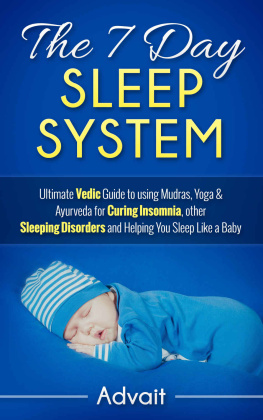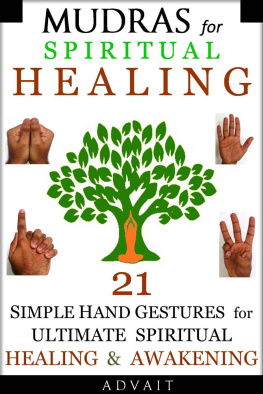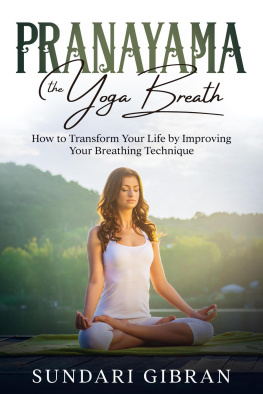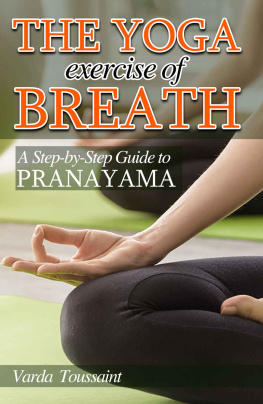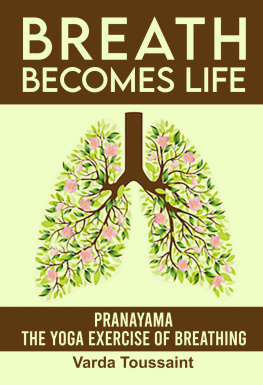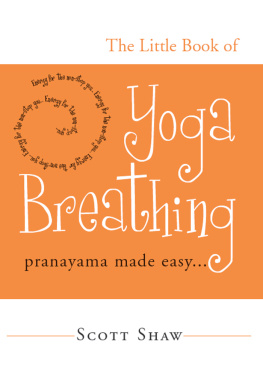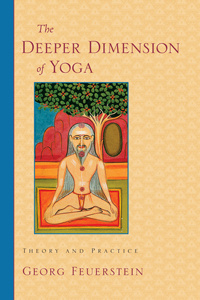Pranayama
* The Vedic Science of Breath *
Ultimate Breathing Techniques
to Calm Your Mind, Relieve Stress
and Heal Your Body
Advait
Copyright 2017, Advait. All rights reserved.
Contents
A Brief History of Yoga
Before starting lets look back at where it all began.
To tell you the truth. No one knows!!
The foundation of Yoga as a science is attributed to Maharshi Patanjali who lived in India in the 3 rd Century B.C.
But, archeological excavations in the Indus Valley civilization sites have unearthed sculptures and idols depicting various Asanas (physical exercise positions) suggested in Yoga and these idols date back to around 3000 years B.C.
Also, information about various aspects of Yoga can be found in Vedic texts like; Shwetashwatrupanishad,
Chaandogyopanishad,
Kaushitki Upanishad,
Maitri Upanishad etc.
This information was scattered all over and Maharshi Patanjali, compiled these nuggets into a streamlined and strict science of Yoga or should I say he compiled this scattered information into a way of life called Yoga through his work Paatanjal YogaSutra
After Maharshi Patanjali, Maharshi Swatwaram wrote Hatapradipika (meaning - One Which Illuminates the Path of Hatha Yoga , i.e. the physical aspect of Yoga) in the 13 th Century A.D.
And, Maharshi Gherand wrote Gherandsanhita around the same time.
Almost all the Yoga methodologies practiced world-over today regard Maharshi Patanjalis work as their reference.
Introduction
The Vedic Science of Breath
Pranayama is considered of paramount importance in Yoga.
The word Pranayama is made of two basic Sanskrit words-
Pran ( ) = Life or Universal Life Energy.
Ayam ( ) = to Extend and Elongate.
Thus Pranayama means an exercise which is to be performed if you want to extend your life.
Pranayama is the fuel of life
Here is an interesting analogy-
You are familiar with the existence of the seven (7) chakras along the spine,
which are considered as the energy points sustaining life and health.
If these Chakras are the rotating wind mills which produce energy to sustain life,
then prana is the essential wind energy which makes the hands of a wind mill rotate, to produce that energy.
When we breathe in we take in the essential oxygen along with the all-pervading Prana.
[And when we breath out we push out the expended energy and toxins out of our body.]
Ayurveda calls our digestion as 'Jathar Agni' literally meaning 'digestive fire', it compares our digestive process with a 'Yadnya' - A holy Pyre, where things are offered to the gods.
And the 'Prana' we take in, is the fuel for this holy Yadnya.
When we practice Pranayama, we regulate and streamline the process of drawing in the universal life force and thus enhancing our health and longevity.
This is the metaphysical Prana aspect of it.
Now let us look at the physical significance, but for that I first need to tell you about our bodies digestive and excretory mechanism.
We consume food, which is broken down into small pieces by our teeth and is added primary digestive enzymes from the saliva in our mouth.
It then passes into our stomach, where it is churned and more gastric juices are added to it to induce breakdown of the food consumed.
This mixture then passes through our intestines, whose walls absorb the nutrients from the food and deposit them into the blood stream to be taken all around the body.
The blood when passing through the lungs also absorbs oxygen that we have inhaled.
So the blood carries the nutrients and the oxygen essential for the cells in our body to break down the nutrients into packets of energy.
Thus the cells of our body get nutrients and oxygen from blood, break down the nutrients into energy and Life is Sustained!!!
But like any other mechanism in this universe, every step produces a byproduct in form of waste.
The food post-digestion in excreted form the intestines in form of stool.
Impurities in our blood are separated in our kidneys and excreted in form of urine.
The impurities/toxins created at the cellular level are in two forms, liquid and volatile.
The liquid toxins are put out by our skin in form of sweat. (You will be surprised to know that our skin is the largest excretory organ in our body)
The volatile toxins (which are most harmful) are thrown out in form of toxic gases using our lungs, when we BREATHE OUT!!!
Pranayama plays a pivotal role here in ridding our bodies of these harmful toxins.
It supplies our lungs and hence our blood with abundant supply of fresh oxygen.
It boosts our immune system.
It is amazingly effective in calming down your mind.
It helps in improving our memory, virility and strengthens our neurological system.
There are many other Pranayama techniques which can be used for multiple other purposes.
(I will tell you everything about those techniques, don't worry :))
There are 7 Pranayama techniques which are widely known and practiced.
Yet, there are many more techniques (almost 50+ that I came across during my study of Pranayama techiques) which are not easily available to the common public,
but have to be actively searched for in various scriptures and Upanishads, which work wonders and are nearly miraculous in their effectiveness.
Starting with the most commonly known ones, I have compiled the most effective and beneficial 14 of those breathing techniques in this book for you.
Before we go any further, I have a special gift for you, turn the page to get it
Free 5 Day email course
"Advanced Pranayama Techniques" email course
This book covers 14 different breathing techniques which are more common, traditional and suitable for beginners and intermediate practitioners alike.
But, once you learn these techniques, you are ready for the next step.
Peculiar breathing methodologies which I call, Advanced Pranayama Techniques, are the ones where we incorporate Micro-Exercises called as sukshma-asanas along with regulated breathing patterns to circulate and fill Prana energy in a particular part of our body, thus nourishing the related organs and enhancing the overall vitality and self-healing capability of our body.
I have compiled such advanced breathing techniques, into a 5 day email course .
And, I am offering the online email course, for FREE to my readers only.
Get your Free, 5 day email course, Advanced Pranayama Techniques here.
Some Important Terminologies
Here are some terminologies youll come across in this book:
Breathing Terminologies-
Purak-
To inhale in to the full capacity of your lungs. Also, when you inhale dont expand your stomach instead fill all the air in your chest.
Kumbhak-
(Kumbh means a pot or a round utensil) To hold the inhaled air in your lungs.
Rechak-
To exhale every ounce of air out of your lungs.
Bandh or Lock terminologies-
Jalandhar Bandh-
To close your wind pipe by pressing your chin against the base of your neck.
Uddiyan Bandh-



